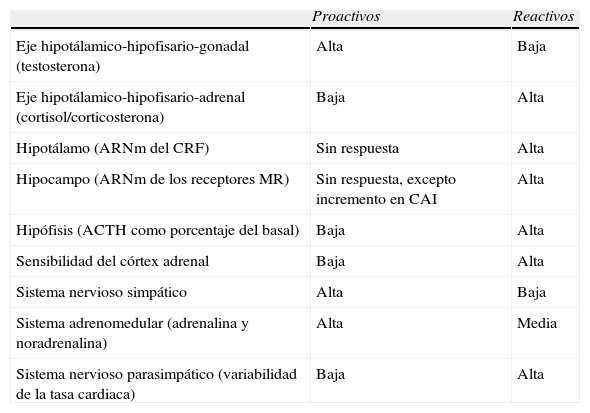Está bien establecido que las consecuencias fisiológicas y patológicas de la exposición al estrés dependen de las características de la situación estresante, pero también de las diferencias individuales. Entre las primeras, la intensidad de la situación, su duración, los niveles de imprevisibilidad y el grado de control sobre la situación juegan un papel crítico. Respecto a las diferencias individuales, existen rasgos de personalidad que pueden modular el impacto de las situaciones estresantes o determinar el patrón general de respuesta conductual y fisiológica a las mismas. No obstante, la respuesta puede depender de las características del estímulo estresante y ni siquiera los sistemas fisiológicos más característicos de la respuesta al estrés como la liberación de catecolaminas y de glucocorticoides responden de la misma forma. Todo ello, combinado con la existencia de diferencias individuales en la susceptibilidad de determinados sistemas fisiológicos (incluyendo el SNC) a los cambios causados por el estrés, hace improbable la existencia de fenotipos con una generalizada baja o alta vulnerabilidad al estrés. Aunque el origen de esta susceptibilidad diferencial no se conoce en muchos casos, se ha demostrado no solo la importancia de factores genéticos sino también de modificaciones epigenéticas (que pueden ser heredables). Los factores genéticos y ambientales pueden no tener por sí mismos efectos importantes, pero sí la combinación de ambos. Este hecho, junto a las modificaciones epigenéticas, requiere un cambio de paradigma en muchas de las investigaciones genéticas sobre el origen de la susceptibilidad al estrés y a otros procesos patológicos.
It has been well established that the physiological and pathological consequences of exposure to stress not only depend on the characteristics of the stressful situation, but also on the individual differences. Among the former, situation intensity, its duration, level of unpredictability and grade of control on the situation play a critical role. Regarding the individual differences, there are personality traits that may alter the impact of the stressful situations or determine the general pattern of behavior and physiological response to them. However, the response may depend of the characteristics of the stressful stimulus and not even the most characteristic physiological systems of response to stress such as the release of catecholamines and glucocorticoid respond in the same way. All of the above, in combination with the existence of individual differences in susceptibility of certain physiological systems (including the CNS) to the stress-induced changes, makes the existence of phenotypes with a generalized low or high vulnerability to stress unlikely. Although the origin of this differential susceptibility is not known in many cases, not only the importance of genetic factors but also the epigenetic modifications (that may be inheritable) have been demonstrated. The genetic and environment factors may not have important effects by themselves, however their combination does. This fact, together with the epigenetic modifications, require a paradigm change in many of the genetic investigations on the origin of susceptibility to stress and to other pathological conditions.
Artículo
Comprando el artículo el PDF del mismo podrá ser descargado
Precio 19,34 €
Comprar ahora







